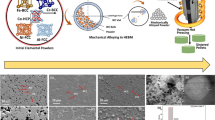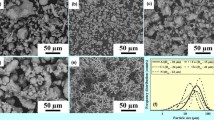Abstract
High-density (98 pct TD) 95W-5Ti (wt pct) alloys have been fabricated by a combustion-synthesis-assisted hot explosive consolidation (CSA-HEC) technique. In the current procedure, a W + Ti powder compact is preheated by the heat released by a Ti + C exothermic combustion synthesis reaction and subsequently consolidated by pressure waves generated by the detonation of an explo-sive. The amounts of explosive charge, sample configuration, and molar ratio of exothermic material to sample were found to affect the degree of consolidation. Auxiliary temperature measurements were performed to determine the precompaction thermal history of the sample to obtain the optimum delay time for consolidation. As observed with scanning electron microscopy (SEM), the CSA-HEC microcomposites consist of W particles surrounded by a partially discontinuous Ti-rich matrix. Trans-mission electron microscopy (TEM) was also used to further characterize the W/Ti interfacial region. The pertinent features of the technique as well as those of the product microstructures are discussed.
Similar content being viewed by others
References
L.S. Magness and T.G. Farrand:Proc. 1990 Army Science Conf, Durham, NC, 1990, Army Science Board, Washington D.C., 1990, vol. 2, pp. 149–64.
T.B. Massalski: inBinary Alloy Phase Diagrams, 2nd ed., H. Okamoto, P.R. Subramanian, and L. Kacprzak, eds., William W. Scott, New York, NY, 1990.
B.H. Rabin, A. Bose, and R.M. German:Int. J. Powder Metall, 1989, vol. 25, pp. 21–27.
G.C. Kuczynski:Sintering Processes, Plenum Press, New York, NY, 1980.
D.W. Smith: inPowder Metallurgy, Applications, Advances, and Limitations, E. Klar, ed., ASM, Metals Park, OH, 1983.
R.M. German:Liquid Phase Sintering, Plenum Press, New York, NY, 1985.
Shock Waves and High-Strain-Rate Phenomena in Metals: Concepts and Applications, M.A. Meyers and L.E. Murr, eds., Plenum Press, New York, NY, 1981.
Metallurgical Applications of Shock Wave and High Strain Rate Phenomena, L.E. Murr, K.P. Staudhammer, and M.A. Meyers, eds., Marcel Dekker, Inc., New York, NY, 1986.
R.R. Boade:J. Appl. Phys., 1969, vol. 40, pp. 3781–85.
A. Cross:Iron Age, 1959, vol. 184, pp. 48–50.
V.G. Gorobtsov and O.V. Roman:Int. J. Powder Metall, 1975, vol. 11, pp. 55–60.
S.S. Batsanov:Effects of Explosives on Materials: Modifications and Synthesis under High-Pressure Shock Compression, Springer-Verlag, New York, NY, 1994, p. 49.
A.K. Bhalla:Trans. Powder Metall. Assoc. Ind., 1980, vol. 7, pp. 1- 8.
N.C. Birla and W. Krishnaswamy:Powder Metall, 1981, vol. 24, pp. 203–09.
S.L. Wang, M.A. Meyers, and A. Szeket:J. Mater. Sci., 1988, vol. 23, pp. 1786–1804.
A. Ferreira, M.A. Meyers, N.N. Thadhani, S.N. Chang, and J.R. Kough:Metall. Trans. A, 1991, vol. 22A, pp. 685–95.
M. Yoshida, Y. Yoshioka, Y. Kimura, H. Hirabayashi, A.B. Sawaoka, and R.A. Puemmer:Aerospace, Refractory and Advanced Materials Advances in Powder Metallurgy, Metal Powder Industries Federation, Princeton, NJ, 1991, vol. 6, pp. 199–209.
A.V. Molotkov, A.B. Notkin, D.V. Elagin, V.F. Nesterenko, and A.N. Lazaridi:Fiz. Gor. Vzr., 1991, vol. 27, pp. 117–26.
S.S. Shang, K. Hokamoto, M.A. Meyers,J. Mater. Sci, 1992, vol. 27, pp. 5470–76.
T. Taniguchi and K. Kondo:Adv. Ceram. Mater., 1988, vol. 3, pp. 399–402.
J.S. Rhinehart and J. Pearson:Explosive Working of Metals, MacMillan Company, New York, NY, 1963, p. 257.
Proc. DARPA/ARMY SHS Symp., MTL-SP-87-3, K.A. Gabriel, S.G. Wax, and J.W. McCauley, eds., Daytona Beach, FL, Oct. 1985, U.S. Govt. Printing Office, Washington, D.C., 1987.
Z.A. Munir:Cer. Bull, 1988, vol. 67, pp. 342–49.
Combustion and Plasma Synthesis of High-Temperature Materials, Z.A. Munir and J.B. Holt, eds., VCH Publishers, Inc., New York, NY, 1990.
A. Niiler, L.J. Kecskes, T. Kottke, P.H. Netherwood, and R.F. Benck :Explosive Consolidation of Combustion Synthesized Ceramics: TiC and TiB2, BRL-TR-2951, U.S. Army Ballistic Research Laboratory, Aberdeen Proving Ground, MD, Dec. 1988.
M.P. Bondar and V.F. Nesterenko:Fiz. Gor. Vzr., 1991, vol. 27, pp. 103–17.
Author information
Authors and Affiliations
Rights and permissions
About this article
Cite this article
Kecskes, L.J., Hall, I.W. Hot explosive consolidation of W-Ti alloys. Metall Mater Trans A 26, 2407–2414 (1995). https://doi.org/10.1007/BF02671254
Received:
Issue Date:
DOI: https://doi.org/10.1007/BF02671254




